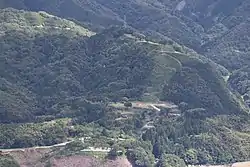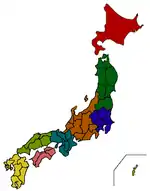Gassantoda Castle
Gassantoda Castle (月山富田城, Gassantoda-jō) was a Japanese castle located in Yasugi, Shimane Prefecture.
| Gassantoda Castle | |
|---|---|
月山富田城 | |
| Yasugi, Shimane Prefecture, Japan | |
 Former site of Gassantoda Castle | |
| Type | Japanese castle |
| Site information | |
| Controlled by | Amago clan (1396 to 1566) Mōri clan (1566-1600) Horio clan (1600-1611) |
| Condition | Ruins |
| Site history | |
| Built | 1396 |
| Built by | Sasaki Yoshikiyo |
| Demolished | 1611 |
| Garrison information | |
| Past commanders | Amago Haruhisa, Amago Yoshihisa, Fukuhara Sadatoshi, Kuchiba Michiyoshi, Kikkawa Hiroie |
History

Gassantoda Castle was constructed in 1396 by Sasaki Yoshikiyo and served as the seat of the powerful Amago clan. It was a mountain castle (yamashiro) regarded as the most impregnable castle in all of Japan, and for the next two centuries was considered the most important castle in the San'in region. Gassantoda Castle was besieged by the Ōuchi clan and Mōri clan in the Siege of Toda Castle, but the Amago managed to repel them. In 1566, after several failed assaults and a prolonged siege, Gassantoda Castle fell to Mōri Motonari and ending the Amago clan as a force in the region. This victory confirmed Motonari's rise to the position of most powerful warlord in Western Japan, and the castle would become one of several castles in the region occupied by the Mōri. In 1600, ownership of Gassantoda Castle was passed to Horio Tadauji for supporting Tokugawa Ieyasu in the Battle of Sekigahara. Tadauji died in 1604 and his father Horio Yoshiharu, serving as the regent of his son and successor Horio Tadaharu, commissioned the construction of Matsue Castle in 1607. Yoshiharu relocated the seat of the Matsue Domain to the new castle upon its completion in 1611, and Gassantoda Castle was subsequently abandoned and demolished. Today, only ruins of the castle still stand in the modern city of Yasugi.
Gassantoda Castle is regarded as among Japan's Five Greatest Mountain Castles, along with Kasugayama Castle, Nanao Castle, Kannonji Castle and Odani Castle. Today it is one of Japan's nationally designated historical ruins.
Gallery
External links
| Wikimedia Commons has media related to Gassan Toda Castle. |
- Japanese Castle Explorer - Gassan Toda Castle
- 戦国の覇者・尼子盛衰記をめぐる page at official site of city of Yasugi





